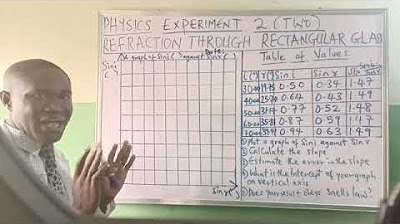Refractive index of a glass slab using a travelling microscope
Summary
TLDRThis video script outlines an experiment to determine the refractive index of a glass slab using a traveling microscope. It explains the concept of real and apparent depth and how they relate to the refractive index. The process involves setting up the microscope, finding the least count, and measuring the real and apparent thickness of the glass slab. The refractive index is then calculated as the ratio of these two measurements. The experiment is repeated for accuracy, and the mean refractive index is determined.
Takeaways
- 🔍 The refractive index is a dimensionless number that indicates how light bends when it passes from one medium into another.
- 📏 The refractive index is calculated as the ratio of the sine of the angle of incidence to the sine of the angle of refraction.
- 🌟 The real and apparent depth concept is used to determine the refractive index of a glass slab.
- 🔬 A traveling microscope is used to measure the real and apparent thickness of a glass slab to calculate its refractive index.
- 📏 The least count of the microscope is determined by the ratio of the length of one main scale division to the number of divisions on the Vernier scale.
- 🛠️ The microscope must be leveled using a spirit level to ensure accurate measurements.
- 📋 A mark is made on a paper to serve as a reference point for measuring the thickness of the glass slab.
- 🔭 The microscope is adjusted to focus on the mark, and readings are taken before and after placing the glass slab.
- 🌌 Lycopodium powder is used to observe the top surface of the glass slab and to take additional readings.
- 📊 The real thickness of the glass slab is calculated by subtracting the initial reading from the reading after placing the slab.
- 🔄 The process is repeated multiple times to find the mean refractive index of the glass slab.
Q & A
What is the refractive index and how does it relate to the propagation of light?
-The refractive index is a dimensionless number that describes how light propagates through a medium. It is the ratio of the speed of light in a vacuum to its speed in the medium. When light travels obliquely from one transparent medium into another, it changes direction due to the difference in refractive indices of the two media.
What is the relationship between the angle of incidence and the angle of refraction in terms of refractive index?
-The relationship is given by the equation where the ratio of the sine of the angle of incidence (I) to the sine of the angle of refraction (R) is a constant, which is the refractive index of the second medium with respect to the first medium.
How can the real and apparent depth be used to determine the refractive index?
-The refractive index of glass with respect to air can be determined by the ratio of the real thickness of the glass slab to its apparent thickness when viewed from above. The apparent depth appears elevated due to the refraction of light through the glass.
What is the aim of the experiment described in the script?
-The aim of the experiment is to determine the refractive index of a glass slab using a traveling microscope by measuring the real and apparent thicknesses of the slab.
What materials are required to perform the experiment?
-The materials required for the experiment include a traveling microscope, a glass slab, a spirit level, lycopodium powder, paper, a marker, and adhesive tape.
What are the main components of a traveling microscope mentioned in the script?
-The main components of a traveling microscope include the eyepiece, objective, vertical main scale, vertical Vernier scale, horizontal Vernier scale, and horizontal main scale.
How is the least count of the microscope determined?
-The least count of the microscope is determined by the ratio of the length of one main scale division to the number of divisions on the Vernier scale.
Why is a spirit level used in the experiment and how is it used?
-A spirit level is used to ensure that the base of the microscope is horizontal, which is crucial for accurate measurements. It is used by adjusting the leveling screws until the bubble in the spirit level is centered.
How is the real thickness of the glass slab calculated in the experiment?
-The real thickness of the glass slab is calculated by taking the difference between the readings R3 (when the microscope is focused on the particles on the top surface of the glass slab) and R1 (the initial reading before placing the glass slab).
How is the apparent thickness of the glass slab determined?
-The apparent thickness of the glass slab is determined by the difference between the readings R3 and R2, where R2 is the reading when the microscope is focused through the glass slab on the mark on the paper.
What is the final step to calculate the refractive index of the glass slab?
-The refractive index of the glass slab is calculated as the ratio of the real thickness to the apparent thickness of the glass slab. The experiment is repeated multiple times to find the mean refractive index for increased accuracy.
Outlines

此内容仅限付费用户访问。 请升级后访问。
立即升级Mindmap

此内容仅限付费用户访问。 请升级后访问。
立即升级Keywords

此内容仅限付费用户访问。 请升级后访问。
立即升级Highlights

此内容仅限付费用户访问。 请升级后访问。
立即升级Transcripts

此内容仅限付费用户访问。 请升级后访问。
立即升级浏览更多相关视频

Newtons ring Experiment

Michelson Interferometer - Part 1 | Construction and find Wavelength | explained in HINDI

Critical Angle Experiment (Total Internal Reflection) - GCSE Required Practical

Thickness and Index from Transparent Films - CompleteEASE Training Series - Video 3/11

How to get your readings without touching any apparatus

Faça um VIDRO DESAPARECER #Shorts
5.0 / 5 (0 votes)
